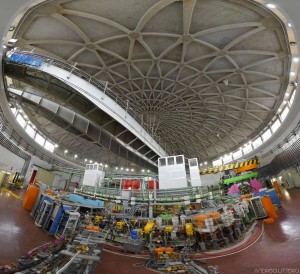The main characteristic of LNF consists in knowing how to build particle accelerators. This path was set with the synchrotron in 1957, continued with AdA and ADONE up to the current DAφNE, the machine with the world record for low energy instantaneous luminosity, a true success.
The technical and scientific expertise of LNF in the field of accelerators is unique in Italy and competitive in Europe, representing an asset that INFN also makes available to society.
In addition to carrying out basic research, LNF has contributed to the implementation of a carbon proton and ion accelerator for medical treatment at the National Center for Oncological Hadron therapy (CNAO) in Pavia.
In this atmosphere of cultural richness, activities complementary to high-energy physics research have been growing, including:
- application of the synchrotron radiation emitted by the electrons of DAΦNE to the study of condensed matter;
- use of electron beams extracted from the DAΦNE injector for the study of new detectors;
- medical and space applications;
- radiation dosimetry and environmental monitoring;
- management of computer networks and construction of advanced computing centers.
Pioneering detectors were also built at LNF, such as streamer tubes, the biggest drift chamber, GEM detectors, etc.
The LNF scientific community is also currently involved in international collaborations at CERN in Geneva, the United States, Germany, China and at other INFN laboratories.
It is our high-quality scientific and technological research programme that allows the laboratory to grow, attract and train new research generations.
 INFN-LNF Laboratori Nazionali di Frascati
INFN-LNF Laboratori Nazionali di Frascati
